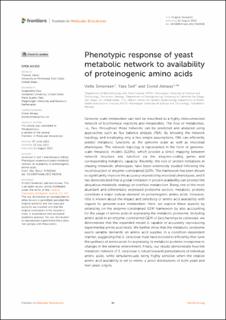| dc.contributor.author | Simensen, Vetle | |
| dc.contributor.author | Seif, Yara | |
| dc.contributor.author | Hall, Martina | |
| dc.date.accessioned | 2022-11-21T08:28:42Z | |
| dc.date.available | 2022-11-21T08:28:42Z | |
| dc.date.created | 2022-09-02T10:22:25Z | |
| dc.date.issued | 2022 | |
| dc.identifier.citation | Frontiers in Molecular Biosciences. 2022, 9 (963548), . | en_US |
| dc.identifier.issn | 2296-889X | |
| dc.identifier.uri | https://hdl.handle.net/11250/3033036 | |
| dc.description.abstract | Genome-scale metabolism can best be described as a highly interconnected network of biochemical reactions and metabolites. The flow of metabolites, i.e., flux, throughout these networks can be predicted and analyzed using approaches such as flux balance analysis (FBA). By knowing the network topology and employing only a few simple assumptions, FBA can efficiently predict metabolic functions at the genome scale as well as microbial phenotypes. The network topology is represented in the form of genome-scale metabolic models (GEMs), which provide a direct mapping between network structure and function via the enzyme-coding genes and corresponding metabolic capacity. Recently, the role of protein limitations in shaping metabolic phenotypes have been extensively studied following the reconstruction of enzyme-constrained GEMs. This framework has been shown to significantly improve the accuracy of predicting microbial phenotypes, and it has demonstrated that a global limitation in protein availability can prompt the ubiquitous metabolic strategy of overflow metabolism. Being one of the most abundant and differentially expressed proteome sectors, metabolic proteins constitute a major cellular demand on proteinogenic amino acids. However, little is known about the impact and sensitivity of amino acid availability with regards to genome-scale metabolism. Here, we explore these aspects by extending on the enzyme-constrained GEM framework by also accounting for the usage of amino acids in expressing the metabolic proteome. Including amino acids in an enzyme-constrained GEM of Saccharomyces cerevisiae, we demonstrate that the expanded model is capable of accurately reproducing experimental amino acid levels. We further show that the metabolic proteome exerts variable demands on amino acid supplies in a condition-dependent manner, suggesting that S. cerevisiae must have evolved to efficiently fine-tune the synthesis of amino acids for expressing its metabolic proteins in response to changes in the external environment. Finally, our results demonstrate how the metabolic network of S. cerevisiae is robust towards perturbations of individual amino acids, while simultaneously being highly sensitive when the relative amino acid availability is set to mimic a priori distributions of both yeast and non-yeast origins. | en_US |
| dc.language.iso | eng | en_US |
| dc.publisher | Frontiers Media | en_US |
| dc.rights | Navngivelse 4.0 Internasjonal | * |
| dc.rights.uri | http://creativecommons.org/licenses/by/4.0/deed.no | * |
| dc.title | Phenotypic response of yeast metabolic network to availability of proteinogenic amino acids | en_US |
| dc.title.alternative | Phenotypic response of yeast metabolic network to availability of proteinogenic amino acids | en_US |
| dc.type | Peer reviewed | en_US |
| dc.type | Journal article | en_US |
| dc.description.version | publishedVersion | en_US |
| dc.source.pagenumber | 12 | en_US |
| dc.source.volume | 9 | en_US |
| dc.source.journal | Frontiers in Molecular Biosciences | en_US |
| dc.source.issue | 963548 | en_US |
| dc.identifier.doi | https://doi.org/10.3389/fmolb.2022.963548 | |
| dc.identifier.cristin | 2048187 | |
| cristin.ispublished | true | |
| cristin.fulltext | original | |
| cristin.qualitycode | 1 | |

